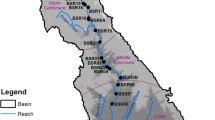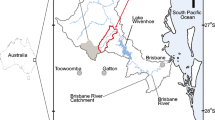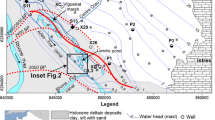Abstract
The direct discharge of groundwater into thecoastal zone has received increased attentionin the last few years as it is now recognizedthat this process represents an importantpathway for material transport. Assessingthese material fluxes is difficult, as there isno simple means to gauge the water flux. Weestimated the changing flux of groundwaterdischarge into a coastal area in the northeastGulf of Mexico (Florida) based on continuousmeasurements of radon concentrations over aseveral day period. Changing radon inventorieswere converted to fluxes after accounting forlosses due to atmospheric evasion and mixing. Radon fluxes are then converted to groundwaterinflow rates by estimating the radonconcentration of the fluids discharging intothe study domain.
Groundwater flow was also assessed via seepagemeters, radium isotopes, and modeling duringthis period as part of an ``intercomparison''study. The radon results suggest that the flowis: (1) highly variable with flows ranging from∼5 to 50 cm/day; and (2) strongly influenced bythe tides, with spikes in the flow every 12hours. The discharge estimates and pattern offlow derived from the radon model matches theautomated seepage meter records very closely.
Similar content being viewed by others
References
Buddemeier RW (Ed) (1996) Groundwater discharge in the coastal zone: Proceedings of an international symposium. LOICZ/R&;S/96-8, iv+179 pp. LOICZ, Texel, The Netherlands
Burnett WC, Kim G &; Lane-Smith D (2001) A continuous radon monitor for use in coastal ocean waters. Jour. Radioanal. Nucl. Chem. 249: 167–172
Burnett WC &; Turner J (2001) LOICZ group investigates groundwater discharge in Australia. LOICZ Newsletter 18: 1–4
Burnett WC &; Dulaiova H (2003) Estimating the dynamics of groundwater input into the coastal zone via continuous radon-222 measurements. Jour. Environ. Radioactivity: submitted
Burnett WC, Bokuniewicz H, Huettel M, Moore WS &; Taniguchi M (2003) Groundwater and porewater inputs to the coastal zone. Biogeochemistry: this issue
Burnett WC, Chanton J, Christoff J, Kontar E, Krupa S, Lambert M, Moore W, O'Rourke D, Paulsen R, Smith C, Smith L &; Taniguchi M (2002) Assessing methodologies for measuring groundwater discharge to the ocean. EOS 83: 117–123
Cable JE, Burnett WC, Chanton JP &; Weatherly GL (1996) Estimating groundwater discharge into the northeastern Gulf of Mexico using radon-222. Earth and Planet. Sci. Lett. 144: 591–604
Clemens LA, Hatchett L &; Hartnett FM (1998) Hydrogeology of the St. Marks River Basin. Wakulla Springs/Woodville Karst Plain Symposium, Florida Geological Survey Special Publication # 46: 11–20
Corbett DR, Burnett WC, Cable PH &; Clark SB (1998) A multiple approach to the determination of radon fluxes from sediments. Jour. Radioanaly. Nucl. Chem. 236: 247–252
Corbett DR, Dillon K, Burnett W &; Chanton J (2000) Estimating the groundwater contribution into Florida Bay via natural tracers 222Rn and CH4. Limnol. Oceanogr. 45: 1546–1557
Happell JD, Chanton JP &; Showers WJ (1995) Methane transfer across the air-water interface in stagnant wooded swamps of Florida: Evaluation of mass-transfer coefficients and isotopic fractionation. Limnol. Oceanogr. 40(2): 290–298
Igarashi G, Saeki N, Takahata N, Sumikawa K, Tasaka S, Sasaki Y, Takahashi M &; Sano Y (1995) Ground-water radon anomaly before the Kobe earthquake in Japan. Science 269: 60–61
Lee DR (1977) A device for measuring seepage flux in lakes and estuaries. Limnol. Oceanogr. 22: 140–147
Macintyre S, Wanninkhof R &; Chanton JP (1995) Trace gas exchange across the air-water interface in freshwater and coastal marine environments. In: Matson PA &; Harris RC (Eds) Biogenic Trace Gasses: Measuring Emissions from Soil and Water (pp 52–97). Blackwell Science Ltd
Martens CS, Kipphut GW &; Klump JV (1980) Sediment-water chemical exchange in the coastal zone traced by in situ radon-222 flux measurements. Science 208: 285–288
Mathieu G, Biscayne P, Lupton R &; Hammond D (1988) System for measurements of 222Rn at low levels in natural waters. Health Physics 55: 989–992
Moore W (1996) Large groundwater inputs to coastal waters revealed by 226Ra enrichments. Nature 380: 612–614
Moore WS (2000) Determining coastal mixing rates using radium isotopes. Continental Shelf Res. 20: 1995–2007
Moore WS (2003) Sources and fluxes of submarine groundwater discharge delineated by radium isotopes. Biogeochemistry: this issue
Paulsen RJ, Smith CF, O'Rourke D &; Wong TF (2001) Development and evaluation of an ultrasonic groundwater seepage meter. Ground Water 39(6): 904–911
Peng TH, Takahashi T &; Broecker WS (1974) Surface radon measurements in the North Pacific station Papa. J. Geophy. Res. 79: 1772–1780
Rasmussen LL, Chanton JP, Furbish DJ, Meacham SP &; Burnett WC (2003) Groundwater flow, tidal mixing and haline convection in coastal sediments: Field and modeling studies. Cont. Shelf Research: in press
Shinn EA, Reich CD &; Hickey TD (2002) Seepage meters and Bernoulli's revenge. Estuaries 25: 126–132
Smith L &; Zawazski W (2003) A Hydrogeologic model of submarine groundwater discharge: Florida intercomparison experiment. Biogeochemistry: this issue
Taniguchi M &; Fukuo Y (1993) Continuous measurements of ground-water seepage using an automatic seepage meter. Ground Water 31: 675–679
Taniguchi M, Burnett WC, Christoff J, Smith CF, Paulsen RJ, O'Rourke D &; Krupa S (2003) Spatial and temporal distributions of submarine groundwater discharge rates obtained from various types of seepage meters at a site in the northeastern Gulf of Mexico. Biogeochemistry: this issue
Turner SM, Malin G, Nightingale PD &; Liss PS (1996) Seasonal variation of dimethyl sulphide in the North Sea and an assessment of fluxes to the atmosphere. Marine Chemistry 54: 245–262
Ullman W &; Aller R (1981) Diffusion coefficients in nearshore marine sediments. Limnol. Oceanogr. 27: 552–556
Valiela I &; D'Elia C (1990) Groundwater inputs to coastal waters. Special Issue Biogeochemistry 10: 328 p
Wagner JR (1989) Potentiometric surface of the Floridan aquifer system in the Northwest Florida Water Management District. Northwest Florida Water Management District Water Resources Map, Series 89-001
Young JE (1996) Tracing groundwater flow into the northeastern Gulf of Mexico using naturally-occurring radon-222. Ph.D. Dissertation, Florida State University: 286 p
Author information
Authors and Affiliations
Corresponding author
Rights and permissions
About this article
Cite this article
Lambert, M.J., Burnett, W.C. Submarine groundwater discharge estimates at a Florida coastal site based on continuous radon measurements. Biogeochemistry 66, 55–73 (2003). https://doi.org/10.1023/B:BIOG.0000006057.63478.fa
Issue Date:
DOI: https://doi.org/10.1023/B:BIOG.0000006057.63478.fa




